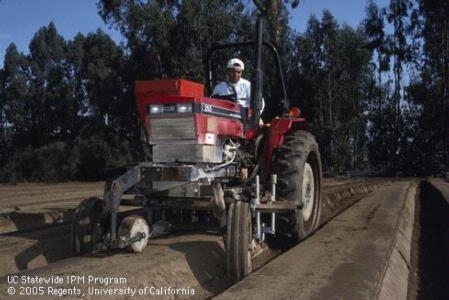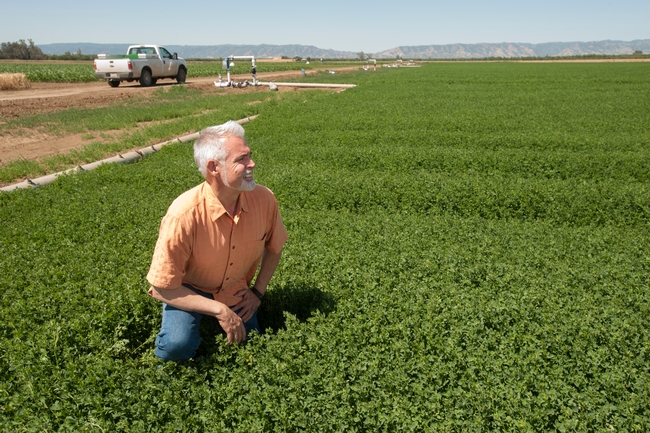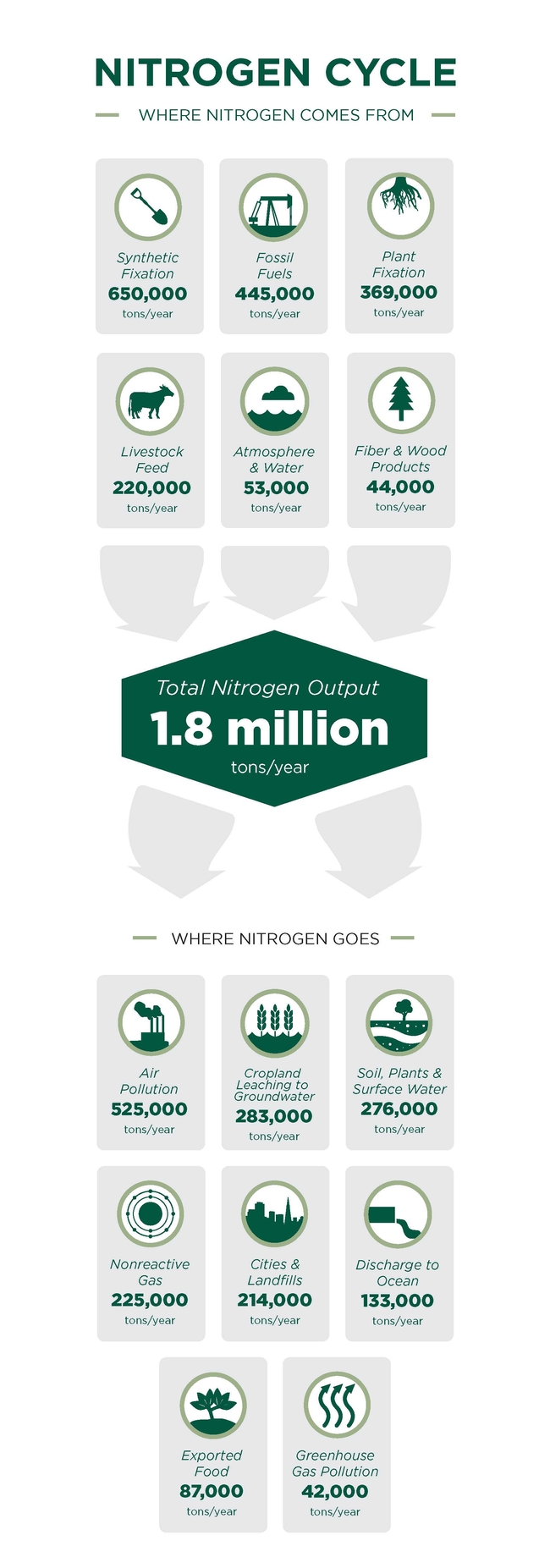Posts Tagged: Tom Tomich
First state-level nitrogen assessment shows the state of the science on nitrogen use and pollution
California paves the way for reconciling agriculture and the environment
Nitrogen is essential for agriculture but also has health and environmental impacts. The California Nitrogen Assessment, a new report from the Agricultural Sustainability Institute at the University of California, Davis presents a big picture of the scale and impacts of nitrogen in the state. The report, published by UC Press, offers a scientific foundation to develop practices and policies that balance nitrogen's benefits and harm.
It's easy for nitrogen to become too much of a good thing, according to the report, which is the first state-level nitrogen assessment. Excess nitrogen can pollute groundwater and air, and impacts the environment, human health, and climate change.
The report shows that excess nitrogen in the state comes primarily from agriculture and fuel combustion.
“This problem was created by all of us,” said lead author Tom Tomich, director of the Agricultural Sustainability Institute at UC Davis. “Nitrogen is an issue that affects and is affected by every Californian.”
Nitrogen in balance
The seven-year, multi-institutional assessment identifies how much nitrogen enters the state, where it is used, and its eventual fate. It consolidates existing scientific knowledge and weighs options for addressing nitrogen management.
“Many programs in California have been recently put in place to help balance the benefit and harm of nitrogen use,” Tomich said. “The California Assessment hopes to contribute to long term solutions and we see farmers as the leaders in positive change.”
Agriculture the major source of California's nitrogen
Each year, about 1.8 million tons of nitrogen enter California. Agriculture represents the largest source of California's nitrogen imports from synthetic fertilizer, livestock feed, and nitrogen-fixing crops, which pull nitrogen from the air and convert it into a usable plant nutrient.
Nitrogen fertilizer helps California produce 21 percent of the nation's dairy commodities and more than half of the nation's fruits and vegetables.
However, vegetable and fruit crops throughout the state use only half of the nitrogen applied to them on average. For livestock, only about a quarter of the nitrogen in animal feed becomes meat or dairy products. The remaining 75 percent becomes manure, which can emit nitrogen into the air as ammonia, a known air pollutant.
Much excess nitrogen from crops leaks into soil and eventually the state's groundwater. Sixteen percent of the state's net nitrogen imports each year, accumulate in groundwater, and 11 percent of nitrogen from crop land and livestock is lost as air pollution.
Nitrogen in groundwater linked to health issues
Nitrogen leaches into groundwater as nitrate, which has been linked with blue-baby syndrome in infants, adverse birth outcomes, and various cancers. While most adults consume more nitrate through food than through drinking water, people who rely on contaminated wells may take in the majority of their nitrate through drinking water.
Parts of the state regularly fail to meet federal drinking water standards for nitrates, and previous reports have shown low-income Latino communities in agricultural regions are the most exposed to groundwater nitrate contamination.
Excess nitrogen in the environment can have detrimental impacts on crop yields, native species and biodiversity, as well.
Nitrogen, fossil fuels, and air pollution
Fossil fuel combustion is responsible for nearly a quarter of the nitrogen coming into the state in the form of nitrogen oxides, which contribute to ozone formation, and ammonia, a component of particulate matter.
Well-established scientific evidence links ozone and particulate matter to poor respiratory and heart health.
Much of the nitrogen oxides and ammonia produced in California are transported downwind from California, making the state a major exporter of nitrogen air pollution.
A very small amount of the state's nitrogen, 2 percent, is released as nitrous oxide, a potent greenhouse gas. Nitrous oxide emissions account for 4 percent of California's total greenhouse gas emissions.
Emissions have declined since 1980 as regulations have pushed fuel efficiency advancements, but nitrogen-related air pollutant levels still exceed state recommendations in many areas.
The path forward
The dispersed, “non-point” nature of nitrogen pollution makes achieving solutions especially challenging. A one-size-fits-all approach will not work for managing nitrogen.
The report highlights practices farmers and ranchers can use to decrease nitrogen losses and save money, such as reducing nitrogen application rates and timing nitrogen application closely with irrigation, practices many farmers in California already are using.
“California has amazing resources to address this issue,” said Rich Rominger, a California farmer and former Director of the California Department of Food and Agriculture. “The state has skilled and motivated farmers and a university system that can continue to dive deep into our unanswered questions about nitrogen. California is often looked to as both an agricultural innovator and an example of strong environmental policy. How we deal with nitrogen can enhance our leadership in these areas.”
The California Nitrogen Assessment was funded primarily by the David and Lucille Packard Foundation, as well as by the UC Division of Agriculture and Natural Resources (UC ANR), and the UC ANR Kearney Foundation of Soil Science.
The book is available at ucpress.edu, and summary materials are available at asi.ucdavis.edu.
More information:
Read the executive summary.
The book, The California Nitrogen Assessment: Challenges and Solutions for People, Agriculture, and the Environment,is available at ucpress.edu.
Solutions to California drought woes may be found in agroecology
The emerging science of agroecology may help scientists find answers to rising challenges facing California agriculture, most immediately the three-year drought, wrote Tom Tomich and Marcia DeLonge in a op-ed published today in the Sacramento Bee. Tomich is the director of the UC Agricultural Sustainability Institute; DeLonge is an agroecologist with the Food and Environment Program at the Union of Concerned Scientists.
The op-ed was published as scientists around the world convene in Sacramento for the Ecological Society of America's annual meeting, where participants will discuss cutting-edge research for a sustainable future.
Agroecology has its roots in crop science and draws on ecology and social sciences to broaden the understanding of agriculture in a broader environmental and societal context, the article says. Several examples of successful agroecology programs are listed, including the UC Davis Russell Ranch, where scientists test an array of farming methods to determine their impact on yield, soil quality, irrigation requirements, energy use and greenhouse gass emissions; and the Marin Carbon Project, which brings together scientists, farmers ranchers and others to sustainably and profitably manage the region's grazing lands.
"So if agroecology shows such great promise, why does it receive a small fraction of available research funding?" the authors ask.
It's time for a change, they said. Investments today will help farmers and all Californians weather climate change and protect the food supply for tomorrow and for generations to come.
More data needed before new fertilizer regulations are imposed
Scientists need more information about how farmers use nitrogen fertilizers before the state imposes new regulations, reported Tim Hearden in Capital Press. Hearden's story was based on a study published in California Agriculture journal.
Nearly 600,000 tons of nitrogen fertilizer is sold in California each year, but sales figures are not an accurate indicator of how it is used.
Imposing regulations without supporting data could fail to address the problem while damaging agriculture, said Tom Tomich, co-author of the study and director of the Agricultural Sustainability Institute at UC Davis.
"One of the other things that's unfortunate about the lack of information is it looks like California farmers have been increasing their nitrogen usage, but if we had better data, farmers would probably look pretty good," Tomich was quoted. "We have a long way to go, just like everyone on the planet. This is one of the biggest challenges facing the 21st century."
See the complete California Agriculture journal article: Nitrogen fertilizer use in California: Assessing the data, trends and a way forward.

Cutting planting slots and placing preplant fertilizer in a two-row strawberry bed.
Feeding the world: Top 100 questions for agriculture
When looking for good answers to big problems, you better make sure you’re asking the right questions – especially when you want to put food on the global table for 9 billion people.
That’s exactly what a team of 55 agricultural and food experts from the world’s major agricultural organizations, scientific societies and academic institutions did recently when they identified the top 100 questions that must be answered if the world is to increase food production by 70 to 100 percent by 2050, when the world’s population is expected to reach 9 billion. Their list appears in the International Journal of Agricultural Sustainability. A PDF of the article is linked at the end of this post.
The top 100 questions cover 13 priority themes and are intended to help frame the research, policy and funding agendas for global agriculture. They were selected from an initial list of 618 questions that had been identified by a core group of experts representing universities, United Nations agencies, research institutes, non-governmental organizations, foundations and regional research secretariats in 23 countries.
Co-author Thomas Tomich, director of the Agricultural Sustainability Institute at UC Davis, predicts that global agricultural and food systems will have to change substantially to meet the growing worldwide demand for food. Looming issues such as climate change, water stresses, energy insecurity and dietary shifts won’t make the challenge any easier, he says.
“California is a hub for technological and scientific innovation, and we can set the pace for a transition to a more sustainable food system, providing inspiration and insights for the world,” Tomich said. “Indeed, if we cannot pull this off in California, who can?”
He noted that it is imperative for the scientific research agenda to keep abreast with the challenges of global food production.
“For California agriculture to stay at the cutting edge in a competitive food system that is facing increasingly complex challenges worldwide, our researchers need to be engaged globally,” he said.
UC Davis' Agricultural Sustainability Institute was founded in 2006. The finstitute is committed to helping ensure access to healthy food and promoting the vitality of agriculture today and for future generations through integrative research, education and communication efforts. The institute includes the UC statewide Sustainable Agriculture Research and Education Program, the UC Davis Russell Ranch Sustainable Agriculture Facility and the UC Davis Student Farm.
Top 100 questions for agriculture (pdf)
UC Davis receives $1.57 million grant from Kellogg
A $1.57 million grant from the Kellogg Foundation will create an endowment for the UC Davis Agricultural Sustainability Institute to support a network of scholars at 14 universities working to improve children's access to healthy food, said a brief article in the Modesto Bee.The article was based on press release distributed yesterday by UC Davis.

Tom Tomich



